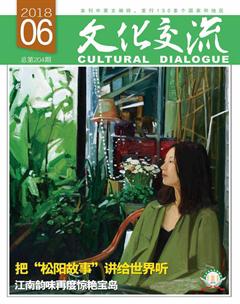把“松阳故事”讲给世界听
徐馨
一
2016年的某一天,青年建筑师徐甜甜的工作邮箱中收到一封来自柏林伊达斯建筑论坛(Aedes Architecture Forum)的来信。信中对她持续多年在中国浙江松阳进行的建筑实践表现出浓厚兴趣。
徐甜甜,中国当代青年建筑师,先后毕业于清华大学、哈佛大学,2004年回到国内成立DnA建筑设计事务所,主要从事公共文化建筑设计。2014年初,徐甜甜第一次来到松阳,那时的她没有想到自己会开启一段漫长又充满生命力的征程。
柏林伊达斯建筑论坛,欧洲最重要的建筑艺术馆,曾于2001年举办“土木”展,首次向世界推介第一代独立建筑师。近年来西扎、库哈斯、卒姆托、弗兰克盖里、妹岛和世、扎哈等人均在此举办过个展。克里斯汀·费哈斯,建筑论坛创建者、艺术总监,业内人士称赞她有一个“敏锐的鼻子”。她和搭档,论坛另一位艺术总监汉斯-尤尔根·科莫瑞尔共同“发现”徐甜甜,起因正是他们主动地想了解中国青年一代建筑师。
“徐甜甜的建筑敏感地创造出新的空间、新的价值。她很特别很优秀,在任何行业,女性若想成功至少须比男性优秀两倍。我们有不同的文化背景,认识不久后我们很快就能感受到,她充满激情,而且这个激情不是作为设计者对设计的渴望,而是意识到建筑是服务他人的媒介。”汉斯说。
于是,经过一年筹备,2018年3月16日,“乡村变迁:松阳故事”建筑文化展在柏林伊达斯建筑论坛开幕。此次“松阳故事”展览接续此前伊达斯的中国缘,更开启一个充满无限可能的新篇章。
“农村的发展关乎人类未来——松阳以建筑为载体进行乡村建设的实践,不仅对德国,对欧洲乃至世界都有借鉴意义。能够‘寻找到松阳故事,我们由衷地高兴和骄傲。”汉斯-尤尔根·科莫瑞尔说。
“德国和中国在农村问题上存在共性。松阳用文化引领并推动乡村发展,把离开家乡的年轻人吸引回来,这对中国其他地区、对世界上其他国家是很好的借鉴。”中国驻德国使馆公使衔文化参赞陈平表示。
此次展览集中展示浙江省松阳县和浙江省“千人计划”专家徐甜甜合作4年多來,以建筑文化牵引乡村发展的9个实践案例:红糖工坊、农耕展览馆、石门廊桥等等。开幕当天,欧盟官员、建筑师、学者、学生,参观者身份不同,络绎不绝。“第一次看到乡土中国”,“原来中德面临同样的乡村问题:文化认同、留住当地人口……”,山水中国及隐在其间的乡村振兴实践激发观众共鸣。
二
中国当代乡村振兴案例为何会在欧洲引起广泛关注?此次展示的每座建筑在当地究竟发挥什么样的作用?让这一切成为可能的,又是怎样的一群人?展览无法传递的故事又有哪些?
2017年12月,浙江松阳。即便在雾霭沉沉的冬季,松阳老街也是一派热气腾腾的生活景象:剪头发、蒸粽子、打铁,每走一步,老街就换上一帧日常画面,不重样的从容。过去十多年中,克里斯汀·费哈斯多次往返中德,置身中国乡村还是第一次。对街坊们来说,也不是第一次见到外国人,但克里斯汀瘦高的身材、热切探究的眼神还是让人好奇:她是谁?
克里斯汀·费哈斯,不仅是伊达斯国际建筑论坛创建者、馆长,她的头衔还有很多:十字勋章获得者、普利兹克建筑学奖评委、2008年北京奥运会建筑场馆评委。不过,克里斯汀的专业并不是建筑学,而是艺术史和哲学研究。取得今天的成就,用克里斯汀的话说,“很简单,我有好奇心。”她总是能够发现未来的建筑大家、提出探索性课题——此次75岁的克里斯汀和汉斯从柏林经芬兰转机抵达上海,再坐7小时汽车走进浙江松阳,正是因为“嗅”到青年建筑师徐甜甜在这里持续进行的建筑设计,以及建筑所依托的乡村振兴实践的独特性与普适性。
“松阳实践最大的特点就是:它实实在在地发生了。38年来,我们在世界上许多地方探讨乡村问题,中国则是踏实地行动。欧洲有些乡建热衷‘大动作,松阳不是这样。松阳就是一个个小项目,每个小项目都能找准地点和时机,彼此适配。据我所知,这一点在国际上也是独一无二的。”克里斯汀说。
松阳农村普通人家世代传承的家谱族谱也让克里斯汀震撼。探究自己从哪里来,困扰了克里斯汀大半生,直到去年她撰写的家族传记出版。“孩子们说,这是我做的所有事情里最棒的一件!”克里斯汀带着自嘲,开心地笑了。4岁那年,克里斯汀遭遇车祸。车祸带走了她的父母和哥哥。直到成年,克里斯汀才忽然意识到,自己失去了8岁以前所有的记忆。为厘清家族历史,克里斯汀四处采访、收集资料,花去15年时间。
三
“最初和村民沟通时,很多人表示想要像上海、北京那样的摩登建筑。我们试着说服村民,建筑不是形式或地标性、个人化签名,一个人再有才华,也比不过几百年传承下来的文明智慧。建筑应该是历史文化的承载者、讲解者,从而连接起脚下土地的过去和未来。”徐甜甜说。今年大年初一,王家后人主动聚集在王景纪念馆朗读族规族训,一位在城里行医的后人领读,另一位做老师的讲解。“王景纪念馆凝聚了人心。现在村里其他姓氏后人受影响,正齐心合力集资修宗祠、修族谱。”王村的邱土基介绍。
利用建筑凝聚人心、建立文化自信,这是松阳考察带给几位策展人共同的印象。“建筑师徐甜甜在松阳进行的全部建筑实践,都由当地工匠来完成,复活当地传统建筑工艺,同时又加入当代理念和技能,推动传统建造工艺的转化与提升,这一点对世界其他地区的建筑实践都有启发。通过建筑,重塑乡村文化自信与自我身份认同,这一点也同样意义深远。”策展人、中国当代建筑研究专家爱德华·克格尔说。
“建筑师和当地政府都非常有使命感,双方都很清楚可以利用当代建筑激发村民的文化认同,从而建立新的乡村自信——这种文化自信是让人们留在农村,甚至吸引离开的人返乡创业的首要元素。同时,这些建筑推动了微观经济发展,将整个乡村盘活。”汉斯为此次展览,两次深入松阳。
“我们通过‘针灸激活方式,以最小介入争取最大效果。根据每个村独有的历史文化和产业特色,因地制宜,激活民俗文化活动,开展项目建造。当这些建造带来经济复兴,村民们就对家乡有了新的价值判断,這种文化自信增强了幸福感和自豪感。同时,推进高效生态农业,借助互联网,推动乡村振兴。”松阳县县委书记王峻说。建筑师徐甜甜创建的系列建筑,就是“针灸疗法”所用的一根根“银针”。
此次“松阳故事”柏林展伊始,策展人克里斯汀特以幻灯片向来宾介绍未能到场的王峻,以此表达敬意和问候:“乡村问题在欧洲也很普遍,现实作为不多,中国则是政府带头在做。王峻是松阳乡建实践主要领导者,有效介入并主导全程,给我留下非常深刻的印象。”
Xu Tiantian, a Chinese architect based in Beijing, was found by Aedes Architecture Forum in 2016. What she did in rural Songyang County in Zhejiang aroused the interest of the forum.
Based in Berlin, Germany, Aedes Architecture Forum is a world-renowned independent institution and exhibition space for the international communication of contemporary architecture and urban design. Established in 1980 as the first private architecture gallery in Europe, the Aedes Architecture Forum has gained a large international partnership network, which feeds to an outstanding cultural platform for the global and public discourse of the built environment. Founded by Kristin Feireiss and Helga Retzer, Aedes has been co-directed by Hans-Jürgen Commerell since 1994.
The forum approached Xu and offered to hold an exhibition to tell the Songyang story to the world. The choice of Xu Tiantian and Songyang represented the rethinking of strategies for rural development, which is now a global pressing challenge.
During the festivities of the Chinese Lunar New Year in 2017, Xu flew to Berlin to meet Ms. Kristin Feireiss and Mr. Hans-Jürgen Commerell. In the following year, the two visited Songyang to help prepare for the exhibition. Mr. Hans-Jürgen Commerell visited Songyang twice to do field studies. In December 2017, Kristin Feireiss visited Songyang to take a look. She had been to China many times over the past 10 plus years but it was her first visit to rural China. The 75-year-old Kristine Feireiss and Hans-Jürgen Commerell flew all the way from Berlin via Finland to Shanghai and then rode a car for 7 hours to reach Songyang.
With preparations of one year, was unveiled on March 16, 2018 at Aedes Architecture Forum in Berlin.
“Rural development is about the future of mankind. Songyangs approach to rural growth through village reconstruction is significant to Germany, Europe, and the world. We are happy and proud to have found the Songyang Story,” commented Hans-Jürgen Commerell.
“Germany and China have rural issues in common. Songyang promotes rural development through culture and attracts the young to come back. This experience is useful to other regions across China and to other countries in the world,” remarked Chen Ping, Cultural Councilor of Embassy of the Peoples Republic of China, at the opening ceremony of the exhibition.
The exhibition in Berlin will proceed till June 17.
The exhibition highlights the nine cases developed by Xu Tiantian in the mountainous landscape of Songyang County, in collaboration with the engaged provincial government and local people.
When she talked with local people shortly after her arrival in Songyang to understand their dreams about rural reconstruction, she found rural residents talk about trendy and ultra-modern buildings in big cities such as Shanghai and Beijing. Xu and her colleagues communicated their idea to the rural population: rural buildings are in no position to rival urban landmarks; neither should they be individual signatures. Instead, village buildings should carry on the wisdom of the past centuries and signify stories of yesteryears and carry on local history and culture.
Wang Jing Memorial Hall, one of the nine cases on display at the exhibition, is a perfect embodiment of this concept. The descendents of the scholar of the Ming Dynasty gathered at the memorial hall on the first day of Chinese Lunar New Year in 2018 to review the family commandments and instructions. The ritual is designed to carry on the family tradition. Moreover, this memorial hall of the Wang clan has inspired other clans in the village to work out their family pedigree books and restore their ancestral temples.
The Songyang Story emphasizes thoughtful “architectural acupunctures” that generate a kind of new “rural self-confidence” and promote the community cohesion.
“The acupunctures strive for minimal interference for maximum effects. Each village has its unique history and culture and unique way of making a living. The revitalization projects aim to suit specific conditions of a village. If revitalization projects can inject economic value and bring about economic revival, villagers will reevaluate their home villages from a new perspective. Such rural self-confidence will not only add a sense of happiness and confidence to local population but also help the growth of green farming and revitalize economic and social growth of rural areas,” said Wang Jun, the chief of the CPC Songyang Committee. Wang considered the buildings designed and built by Xu Tiantian as needles for the architecture acupunctures.
Wang has played a crucial role in the rural revitalization project in Songyang. Due to a tight work schedule, he wasnt able to fly to Berlin to attend the opening ceremony of the Songyang Story. At the opening ceremony, a series of slides, created by Kristine Feireiss, was screened in honor of Wang Jun. “Rural issues are common in Europe, but practices are not so many. In China, the government leads the rural revitalization project. Wang Jun is a chief decision maker and leader of the rural development in Songyang. He is effectively engaged in the project and plays a chief role in the whole process. I am deeply impressed,“ remarked Kristine Feireiss.

